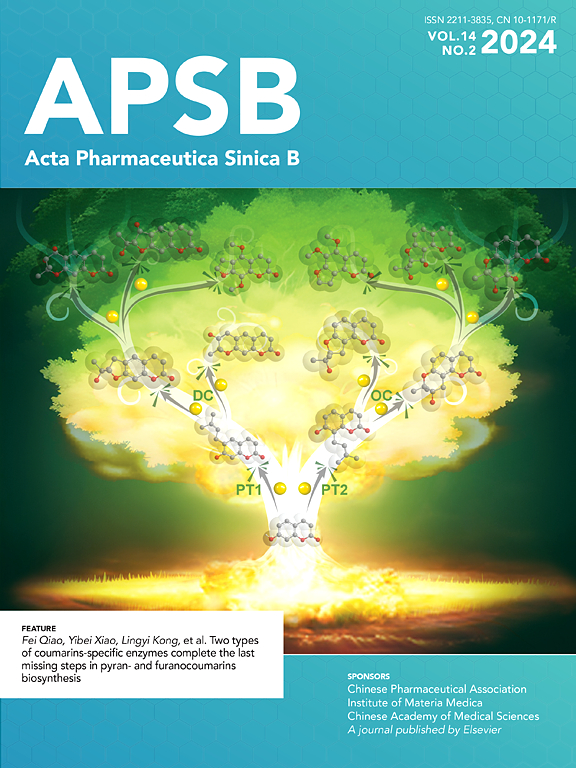用于高对比度体内成像的微蛋白进化引导设计
IF 14.6
1区 医学
Q1 PHARMACOLOGY & PHARMACY
引用次数: 0
摘要
传统的小蛋白支架的开发依赖于显示技术和基于突变的工程技术,这些技术限制了小蛋白支架的序列和功能多样性,从而制约了小蛋白支架的治疗和应用潜力。蛋白质设计工具极大地促进了新的蛋白质序列、结构和功能的创造。然而,为了更有效地优化蛋白质基药物的功能性能和增强其药物性,还需要进一步改进设计策略。在这里,我们扩展了一种基于进化的设计方案,创建了一种新的小型粘合剂BindHer,用于对抗人类表皮生长因子受体2 (HER2)。它不仅具有超高的稳定性和结合选择性,而且具有显著的组织特异性。99mTc、68Ga和18F的放射性标记实验表明,BindHer在her2阳性乳腺癌小鼠模型中有效靶向肿瘤,非特异性肝脏吸收最小,优于传统工程设计的支架。这些发现强调了一种新的合理的自动化蛋白质设计方法,为治疗性微型蛋白质开发的大规模应用提供了巨大的潜力。本文章由计算机程序翻译,如有差异,请以英文原文为准。

Evolution-guided design of mini-protein for high-contrast in vivo imaging
Traditional development of small protein scaffolds has relied on display technologies and mutation-based engineering, which limit sequence and functional diversity, thereby constraining their therapeutic and application potential. Protein design tools have significantly advanced the creation of novel protein sequences, structures, and functions. However, further improvements in design strategies are still needed to more efficiently optimize the functional performance of protein-based drugs and enhance their druggability. Here, we extended an evolution-based design protocol to create a novel minibinder, BindHer, against the human epidermal growth factor receptor 2 (HER2). It not only exhibits super stability and binding selectivity but also demonstrates remarkable properties in tissue specificity. Radiolabeling experiments with 99mTc, 68Ga, and 18F revealed that BindHer efficiently targets tumors in HER2-positive breast cancer mouse models, with minimal nonspecific liver absorption, outperforming scaffolds designed through traditional engineering. These findings highlight a new rational approach to automated protein design, offering significant potential for large-scale applications in therapeutic mini-protein development.
求助全文
通过发布文献求助,成功后即可免费获取论文全文。
去求助
来源期刊

Acta Pharmaceutica Sinica. B
Pharmacology, Toxicology and Pharmaceutics-General Pharmacology, Toxicology and Pharmaceutics
CiteScore
22.40
自引率
5.50%
发文量
1051
审稿时长
19 weeks
期刊介绍:
The Journal of the Institute of Materia Medica, Chinese Academy of Medical Sciences, and the Chinese Pharmaceutical Association oversees the peer review process for Acta Pharmaceutica Sinica. B (APSB).
Published monthly in English, APSB is dedicated to disseminating significant original research articles, rapid communications, and high-quality reviews that highlight recent advances across various pharmaceutical sciences domains. These encompass pharmacology, pharmaceutics, medicinal chemistry, natural products, pharmacognosy, pharmaceutical analysis, and pharmacokinetics.
A part of the Acta Pharmaceutica Sinica series, established in 1953 and indexed in prominent databases like Chemical Abstracts, Index Medicus, SciFinder Scholar, Biological Abstracts, International Pharmaceutical Abstracts, Cambridge Scientific Abstracts, and Current Bibliography on Science and Technology, APSB is sponsored by the Institute of Materia Medica, Chinese Academy of Medical Sciences, and the Chinese Pharmaceutical Association. Its production and hosting are facilitated by Elsevier B.V. This collaborative effort ensures APSB's commitment to delivering valuable contributions to the pharmaceutical sciences community.
 求助内容:
求助内容: 应助结果提醒方式:
应助结果提醒方式:


